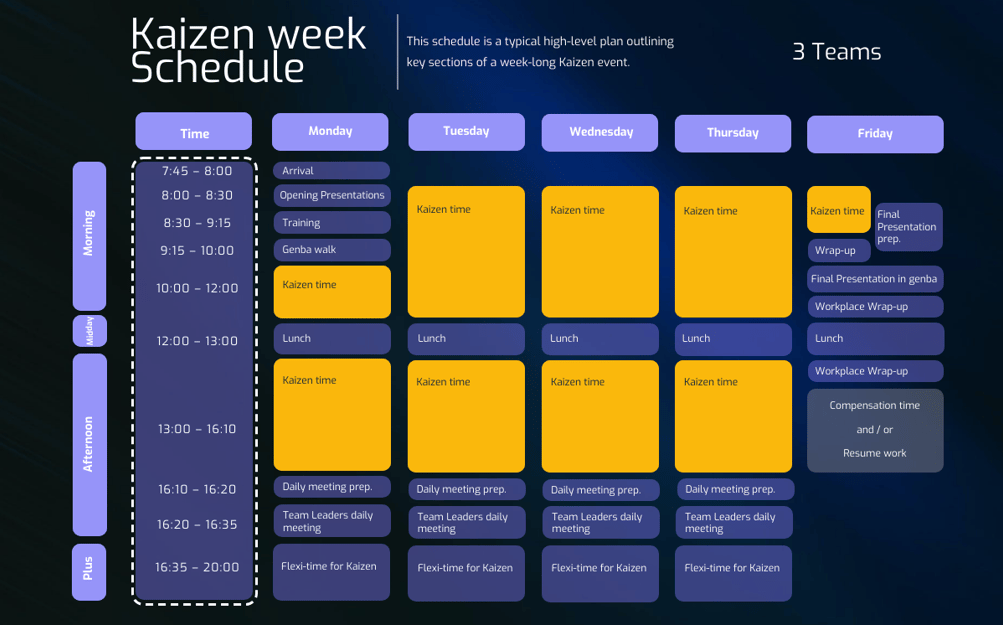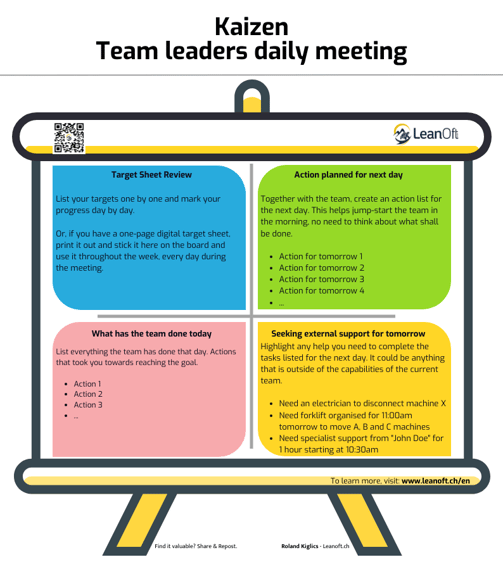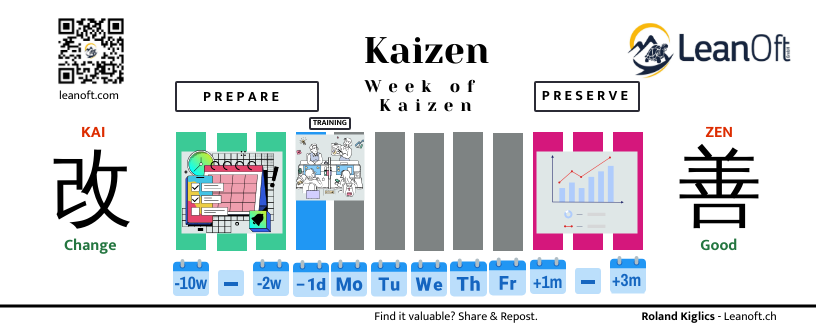How to conduct a Kaizen “event" successfully & ensure sustainment
A Kaizen "event" is not a one-off affair, but a series of structured activities designed to drive continuous improvement. A well-defined agenda, working according to the 10 Commandments of Kaizen and working in Genba are essential, especially if you want to challenge the status quo and achieve sustainable growth.
CONTINUOUS IMPROVEMENTKAIZEN
Roland Kiglics
10/8/20247 min read
Introduction
This is my fourth article in my Kaizen series. In the previous articles, I used my experience to describe what Kaizen and Kaizen “events” are, I reviewed the key elements of a successful Kaizen and showed how to prepare for a successful Kaizen “event” or Kaizen week.
Before we go any further, a quick refresher: First and foremost, a Kaizen "event" is not just an event, nor does it happen once every leap year. It takes place several times a year and is scheduled in the business’ Kaizen calendar. Usually it takes 3 to 5 days, and involves a team of 6-8 people, or multiple teams. The aim is to implement a solution to an existing problem and integrate it into standard work, which is the foundation for future improvements.
Why is this distinction important? In short, because Kaizen is about action—a hands-on activity that facilitates learning for both participants and the organization as a whole.
Kaizen week => Actual change for better
Typical schedule of a Kaizen week
In my previous article on Kaizen “event” preparation, I emphasized the importance of an agenda where the actions are listed. This agenda serves as a guide for both teams and leadership, outlining what should happen and when during the Kaizen week. Each team has their own, separate agenda for the week.
Notice the more detailed first day? This is intentional, as the initial day can be chaotic for teams. Kaizen teams often include members who don't know each other well. On day one, besides learning about the process and visiting the genba, team members may receive training on new Lean/TPS tools while going through a forming period. A detailed first-day agenda, created during pre-work, guides the team through this crucial initial phase.
The agenda's significance lies in its role as a standard work guide for the team, providing a high-level schedule without being overly prescriptive.
It might look something like this:
The agenda repeats several elements:
Time for Kaizen
Genba walks
Team Leaders daily meetings
Flexi-time for Kiazen


Elements of a Kaizen week
This forms the core of the week and includes various activities tailored to the problem at hand.
Kaizen Time


The try-storming cycle continues until a final solution is successfully implemented sometime towards the end of the Kaizen week usually on Thursday. This approach is great as it emphasizes rapid experimentation: fail fast, learn quickly and try again.
This is reserved time to optionally extend the day if needed. It's important to consider how many hours team members have already worked that day. While I don't recommend mandating overtime, this time is reserved because teams may choose to continue working to complete tasks for the next day or to facilitate the work of a support team working overnight. On the other hand, I've seen cases where a team could have stayed an extra 30 minutes to finish something, but decided to leave anyway.
Genba Walks
These walks may differ between manufacturing facilities, hospitals, or offices, but the goal remains the same: to demonstrate actual changes implemented, not just future plans in a presentation.
This is another important element in the agenda and it usually takes place twice during the week for the whole team:
The meeting is limited to 5 minutes per team, focusing on progress overview and next-day planning. It is best practice for the review committee to visit each team at their workplace and allow the teams to present their actions.
Note: This meeting is for progress review and requesting help, not for problem-solving or extensive discussions. Collaboration between teams is also encouraged, but team leaders should ensure that teams do not merge. To maintain consistency, I usually ask teams to fill out a small 2x2 matrix with relevant information.
Daily team leader meetings
Flexi-time for Kaizen
The process is typically as follows:
First day: Some training, learning the process in genba and reviewing data.
Subsequent days: The team goes into try-storming mode.
Try-storming is an innovative, dynamic method within the Kaizen philosophy that combines brainstorming with rapid prototyping and testing of ideas in a real-world environment. It emphasizes action and rapid experimentation over extensive discussion or planning.
Key principles of Try-Storming:
Action-oriented: Focuses on executing ideas rather than just generating them.
Simplicity: Encourages straightforward solutions that are easy to test.
Iterative process: Involves rapidly prototyping, testing and refining based on feedback.
Benefits:
Quickly identifies viable ideas while eliminating ineffective ones.
Engages participants creatively and practically.
Accelerates the transition from ideas to working solutions.
For more details on try-storming, please see my previous article. There I introduce it through Moonshining, which is a form of Kaizen.
At the beginning of the week (always at the beginning of the first day): To familiarize participants with the current state.
At the end of the week (usually Friday): To showcase changes and final solutions.
Held towards the end of each day, these meetings serve to:
Summarize progress for the team and management, self control and accountability for the team – review target sheet
Inform the other teams and facilitate collaboration between teams
Avoid "overproduction" (multiple teams solving the same problem)
Request support and help from management to remove barriers
You may have noticed that Friday's agenda is shorter. This allows team members to compensate for any extra hours worked during the week and / or ensures that the Kaizen event wraps up by lunchtime, giving time in the afternoon to prepare operations for the next working day. Always keep in mind local regulations regarding working hours and labour, as these can vary significantly by country. This flexibility could benefit both management and participants.
When organising a multi-team Kaizen week, it's important to have someone with significant Lean/TPS experience to oversee the work of all teams. This person coaches the teams and is not part of any particular team. The role of the coach is to conduct several daily genba walks to each team's work area, providing guidance and ensuring progress.
Sustaining your Kaizen improvements
A good Kaizen culture is a lot about learning. Reflecting on both successes and failures/challenges will help improve future Kaizen events and foster a culture of continuous improvement.
Focus on sustainment for the next 10-12 weeks.
Create a Post-Kaizen Sustainment Plan during the event, including:
In the first 1-3 weeks:
Conduct a self-assessment:
Continue to review results for 10-12 weeks:
Maintain the Kaizen team until the end of the sustainment period:
An action plan with some items to complete
Daily management elements to drive action and accountability
Verify Kaizen results through daily management
Close any remaining open items (should be minimal, max 1-3 items)
Reflect on what went as planned, better than expected or poor
Share best practices and lessons learned with other teams
Ensure new standard work (including leaders' standard work) is being followed.
Use continuous improvement to address small 'hiccups' and fine-tune the new process.
Team members' insights can be valuable for fine-tuning
Ensure that all confirmed improvements are working as intended
10 Commandments / Rules of Kaizen
These commandments foster a culture of continuous improvement, encouraging active participation, creative problem-solving, and a focus on immediate, tangible results.
Stay focused: Keep in mind the boundaries established during pre-work.
100% participation: This means that while participants are present, they should be fully engaged and by others considered as they were “out of office.” Their focus should be entirely on the Kaizen activities, allowing for meaningful contributions and collaboration throughout the event.
Maintain a process focus: This enables blame-free cooperation and creates a safe environment for truth to surface.
Think creatively, not financially: Use your head, not your wallet - prioritize creativity over spending money.
Leave job titles at the door: Create an even playing field for an open and safe environment that maximizes success.
Empower the team: The team has ultimate deciding power on implementations. Outside interference can be damaging. Ensure the process owner/leader is part of the team or delegates 100% decision power.
Use words meaningfully: Focus on how things can be done, not why they can't. Ask open-ended questions that invite thinking rather than rejection. Examples: "How could it be done?", "What if...", "What have we learned from past attempts?"
Value immediate action: A small improvement today is worth more than a plan for tomorrow or perfection someday.
Seek ideas from everyone: Disagreement is okay, but being difficult isn't. Maintain professionalism and support.
Challenge the status quo: Discard old ways of thinking and avoid making excuses.
A Kaizen "event" is a dynamic series of activities designed to promote continuous improvement, rather than a single event. Key components such as Kaizen Time, Genba Walks and daily team leader meetings create a structured environment for collaboration and accountability. The flexibility offered by flexi-time facilitates employee engagement. Importantly, the completion of a Kaizen also marks the start of the sustainment phase, where teams evaluate results and refine processes, emphasizing that progress is more important than perfection. This continuous cycle of reflection and improvement ensures that the momentum of change continues beyond the event itself.
Conclusion
Next Steps
Now, that we know all about large, transformative Kaizens, aka, Kaizen “events”, I will dive into how continuous improvement and small(er) Kaizens fit together with them. Please come back later to read more about this topic.
Further reading
Bob Emiliani, Katsusaburo Yoshino, Rudy Go (2015). Kaizen Forever: Teachings of Chihiro Nakao. Wethersfield, Connecticut, USA: CLBM, LLC.
Barney Art (2017). The Lean Turnaround Action Guide: How to Implement Lean, Create Value, and Grow Your People. New York, USA: McGraw-Hill.
“Ask Art: What Was Danaher Like In the Early Days of Lean?” By Barney, Art, 17 September 2020
Jean E. Cunningham, Orest Fiume, Emily Adams (2003). Real Numbers: Management Accounting in a Lean Organisation. Boston, MA 02210 USA: Lean Enterprise Institute, Inc.
Video to watch
“Exploring the gaps in people’s understanding of Kaizen” by Emiliani Bob, (2024)
Book Your First Consultation
Get in touch to discuss how LeanOft can help you today.
Get to know us
Do you prefer personal contact over a form? Take the opportunity and write an email to get to know LeanOft and the people behind it.
Quick and Direct Access
Give us a call:
+41779456508
LeanOft GmbH provides hands-on, People-Centered Lean implementation support and problem solving for organizations that want to be better tomorrow than they are today.
LeanOft GmbH is primarily based in Switzerland and is working with companies in Switzerland and in Europe
Follow us
COPYRIGHT © 2025 LeanOft GmbH


+41779456508


